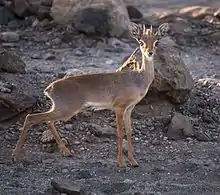Salt's dik-dik
Salt's dik-dik (Madoqua saltiana) is a small antelope found in semidesert, bushland, and thickets in the Horn of Africa, but marginally also in northern Kenya and eastern Sudan.[1] It is named after Henry Salt, who was the first European to acknowledge the species in Abyssinia in the early 19th century.[2][3]
| Salt's dik-dik | |
|---|---|
 | |
| Salt's dik-dik in the wild of Africa | |
| Scientific classification | |
| Domain: | Eukaryota |
| Kingdom: | Animalia |
| Phylum: | Chordata |
| Class: | Mammalia |
| Order: | Artiodactyla |
| Family: | Bovidae |
| Subfamily: | Antilopinae |
| Genus: | Madoqua |
| Species: | M. saltiana |
| Binomial name | |
| Madoqua saltiana (de Blainville, 1816) | |
 | |
| The range of Salt's dik-dik | |
Description
Salt's dik-diks are 52–67 cm (20–26 in) long, 33–41 cm (13–16 in) high, and weigh 2.5–4.0 kg (5.5–8.8 lb).[4] As in other dik-diks, the small, pointed horns are only present in the male.[5] Their colour varies significantly depending on the subspecies.
Taxonomy
Together with the closely related silver dik-dik, this species forms the subgenus Madoqua in the genus Madoqua (other dik-diks are also in the genus Madoqua, but the subgenus Rhynchotragus).[6][7] The taxonomy of this subgenus is complex and a matter of dispute. Today, the most widely used treatment is based on a review in 1978,[8][9] but a significantly different treatment was presented in a review in 1972.[6] Following the review in 1978, the silver dik-dik is treated as a separate monotypic species, and Salt's dik-dik has five subspecies:[4][9]
- M. s. saltiana is found from northern Ethiopia to Eritrea and far eastern Sudan, and is relatively large with a reddish-grey back.
- M. s. hararensis is found in the Hararghe region in eastern Ethiopia, and has a gingery back and dark red flanks.
- M. s. lawrenci is found in eastern and southeastern Somalia, and has a silvery back and russet flanks.
- M. s. phillipsi is found in Somaliland, and its back is grey and flanks are orange.
- M. s. swaynei is found in the Jubba Valley region of southern Ethiopia, southern Somalia, and far northern Kenya; its back is brown-grey.
In 2003, each of the above was proposed to represent an evolutionary species,[10] but at present, most maintain them as subspecies.[1][9] The review in 1972 differed significantly from the above. Under that treatment, three species are recognized in the subgenus Madoqua: Salt's sik-dik (M. saltiana with the subspecies saltiana and cordeauxi), Phillip's dik-dik (M. phillipsi with the subspecies phillipsi, gubanensis, hararensis, and lawrencei), and Swayne's dik-dik (M. swaynei with the subspecies swaynei, erlangeri, and piancentinii).[6] Of these taxa, M. s. cordeauxi, M. p. gubanensis, and M. p. erlangeri were considered entirely invalid in 1978.[8]
Behavior
Salt's dik-diks are shy animals. They are active at night and dusk to avoid the midday heat, and are considered crepuscular. Dominant dik-diks flare their crests. The animals are most often found in pairs and small groups, and Salt's dik-diks mainly eat leaves and shoots of acacia trees. Due to ecological factors, Salt's dik-diks have a considerably lower basal metabolic rate than other ruminants that inhabit temperate and cold climates.[11]
Reproduction
The gestation period lasts approximately 150 –180 days. Female dik-diks give birth to 1 cub twice a year. The newborn is hidden in the nesting area for at least 2–3 weeks. After 1 week, an infant is able to eat solid food. However, it continues to nurse for 3–4 months. After the first month of life, young males begin to grow their horns. Salt's dik-dik reaches adult size after 8 months and stops growing completely after 12 months. As soon as the young dik-dik reaches sexual maturity (6–9 months), it establishes a territory with a mate. [12]
References
- IUCN SSC Antelope Specialist Group (2016). "Madoqua saltiana". IUCN Red List of Threatened Species. 2016: e.T12668A50190537. doi:10.2305/IUCN.UK.2016-1.RLTS.T12668A50190537.en. Retrieved 11 November 2021.
- "Salt Dik-dik - Big Game Hunting Records - Safari Club International Online Record Book". www.scirecordbook.org. Retrieved 14 April 2018.
- "Book Details". www.abebooks.com. Retrieved 14 April 2018.
- Kingdon, J. (1997). The Kingdon Guide to African Mammals. Academic Press. ISBN 0-12-408355-2
- Haltenorth, T., and H. Diller (1980). Mammals of Africa Including Madagascar. HarperCollins. ISBN 0 00 219778 2
- Ansell, W. F. H. (1972). Order Artiodactyla. Part 15. Pp. 1-84. in: Meester, J., and H. W. Setzer, eds (1972). The mammals of Africa: An identification manualSmithsonian Institution Press, Washington, D.C.
- Wilson, D. E.; Reeder, D. M., eds. (2005). Mammal Species of the World: A Taxonomic and Geographic Reference (3rd ed.). Johns Hopkins University Press. ISBN 978-0-8018-8221-0. OCLC 62265494.
- Yalden, D. (1978). A revision of the dik-diks of the subgenus Madoqua (Madoqua). Monitore Zoologico Italiano, n.s. suppl. 11: 245-264.
- Wilson, D. E.; Reeder, D. M., eds. (2005). Mammal Species of the World: A Taxonomic and Geographic Reference (3rd ed.). Johns Hopkins University Press. ISBN 978-0-8018-8221-0. OCLC 62265494.
- Cotterill, F. P. D. 2003. Species concepts and the real diversity of antelopes. in: Plowman, A., eds (2003). Proceedings of the Ecology and Conservation of Mini-antelope: An International Symposium on Duiker and Dwarf Antelope in Africa. Filander Verlag: Füürth. pp. 59-118.
- Dittmann, Marie T.; Hebel, Christiana; Hammer, Sven; Hummel, Jürgen; Ortmann, Sylvia; Arif, Abdi; Bouts, Tim; Kreuzer, Michael; Clauss, Marcus (2014-01-01). "Energy requirements and metabolism of the Phillip's dikdik (Madoqua saltiana phillipsi)". Comparative Biochemistry and Physiology Part A: Molecular & Integrative Physiology. 167: 45–51. doi:10.1016/j.cbpa.2013.09.014. ISSN 1095-6433. PMID 24095724.
- CASTELLÓ, José R. BOVIDS OF THE WORLD: Antelopes, Gazelles, Cattle, Goats, Sheep, and Relatives. Princeton University Press, 2016, pp 216–217. ISBN 978-0-691-16717-6.
